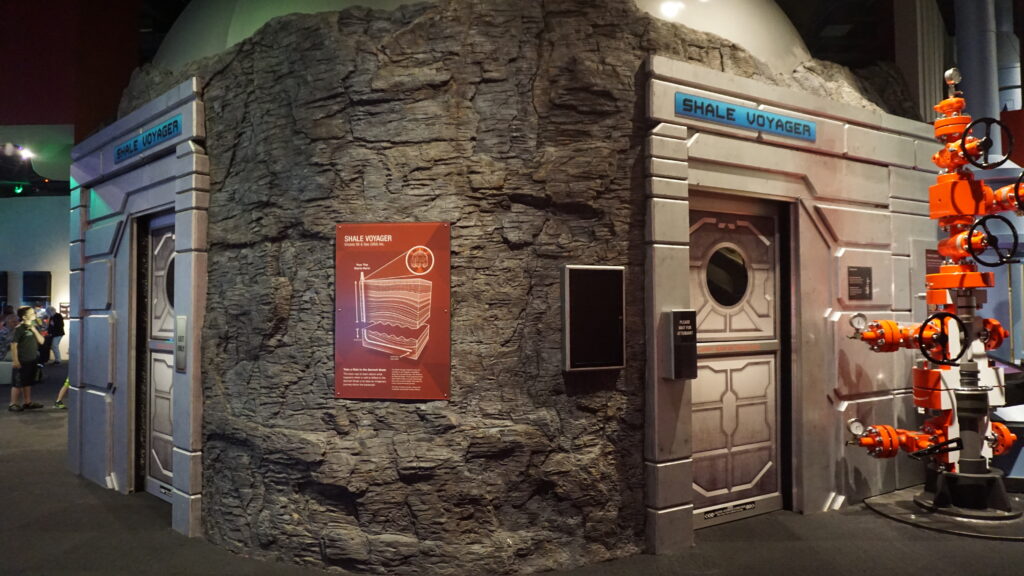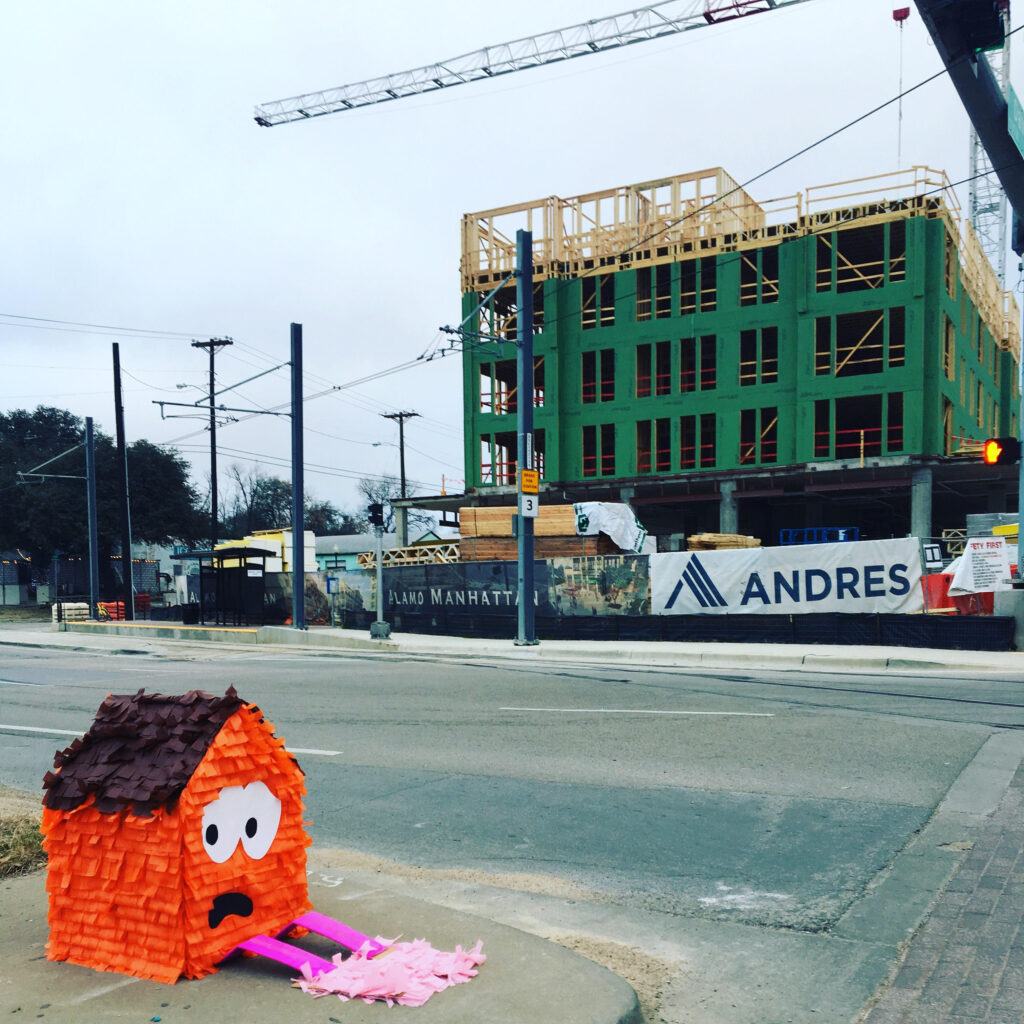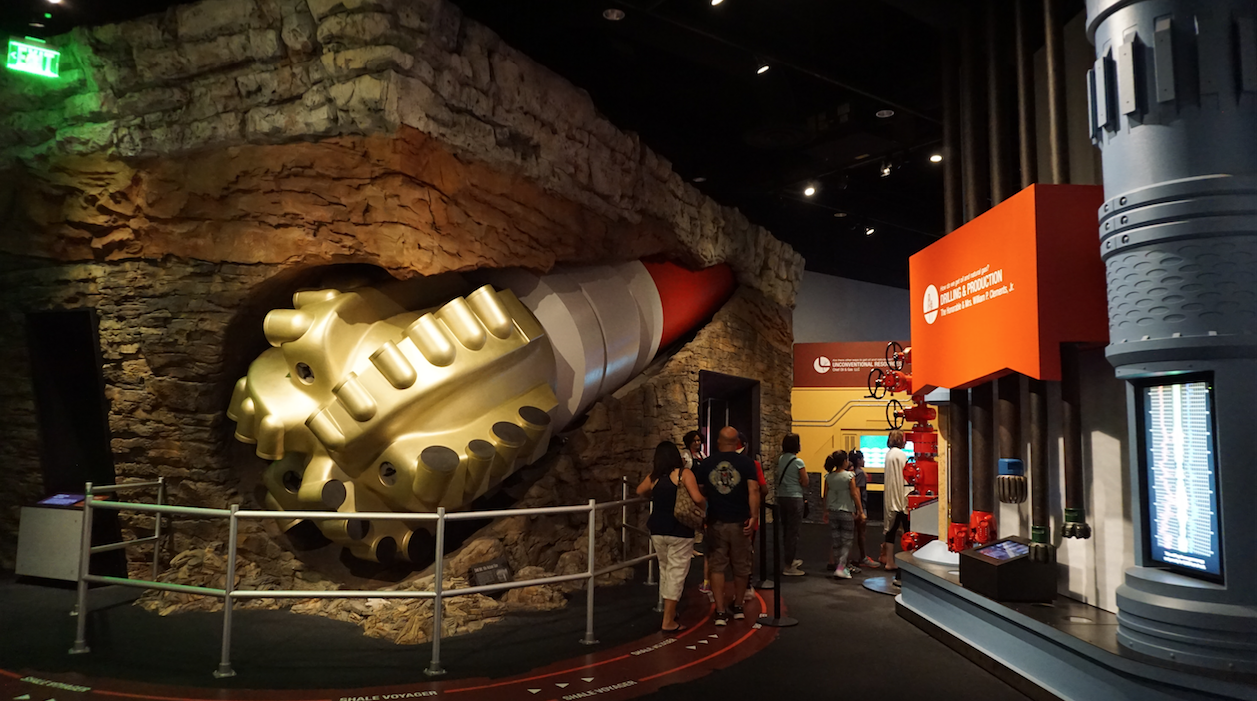On the third floor of the Perot Museum of Nature and Science in Dallas, Texas, couched between dinosaur skeletons and luminescent gems and crystals, sits the Tom Hunt Energy Hall. Plans for the hall were announced in 2008, declaring it a “world-class and Texas-sized…6,500-square-foot gallery” dedicated to “exploring how science and technology are used to capture the vast array of traditional and alternative energy resources.” The present day hall is primarily a tribute to horizontal drilling and hydraulic fracking. A gigantic model of a hydraulic fracking drill cuts diagonally through a corner wall fabricated to look like layers of subterranean earth and shale. This monumental adornment sets the stage for the various interactive and immersive media displays in the exhibit. Wall texts describe natural gas harvested by fracking as an “unconventional energy” source found within the Barnett Shale, the geological rock formation that lies 5,000 feet underneath at least seventeen counties around Fort Worth. On a small corner display screen, an animated charismatic cowboy sings an apologetic ode to “Urban Drilling in the Barnett Shale.” One small footnote on a textual display mentions fracking’s “potential impacts currently under research”: earthquake generation, groundwater contamination, and use of water resources. These are listed underneath an equivalent list of fracking’s benefits: an independent US energy source, fracking increases employment and decreases taxes.
High-yielding fracturing of the Barnett precipitously began in the 2000s. A century after the discovery of oil at Spindletop, Texas, in 1901, the profit potential of the Barnett Shale spurred the global “shale boom,” sending geologic prospectors into subterranean searches in Argentina, Brazil, Mexico, and other global sites. In the ten years since the Energy Hall’s announcement, rates of earthquakes in Texas with magnitudes greater than three have risen from two to twelve a year. A scientific study published in 2016 by the University of Texas points blame for the rise in earthquakes to the wastewater that fracking pumps underground.
The Perot Museum Energy Hall was funded by a ten million dollar donation from the Hunt Petroleum Corporation, the oil company founded by H. L. Hunt in 1950. The Hunt name is ubiquitous in Dallas, often funding its hyperbolic entrepreneurial and infrastructural projects. Hunt himself is an enigmatic presence in Texas culture; once rumored the richest man in the world, he bore fifteen children from three wives. Two of the three marriages were clandestine. He is cited as character inspiration for J. R. Ewing, the scheming oilman protagonist of the television show “Dallas.”
The exhibition aesthetics of the Tom Hunt Energy Hall evince the larger petroculture that permeates modern life and finds a specific regional manifestation in Dallas. Stephanie LeMenager describes petroculture as the aesthetics—modes of sensing, perceiving, and representing—that derive from petroleum and that “mediate our relationship, as humans, to other humans, to other life, and to things” (6). Like J. R. Ewing, the Hunt Energy Hall is larger-than-life, bombastic, and unapologetically disingenuous, yet charismatic and charming in its particularly Southern euphemistic address. Ewing and the hall share a deregulated, individualist, and lubricated relationship to work and profit without physical labor that has defined US development and expansion. These aesthetics resonate with the “carbon-heavy masculinities” described by Stacy Alaimo that pervade Texas, manifesting in increasingly large, military-style vehicles, sometimes altered to be less fuel efficient and more pollutive, and occasionally displaying synthetic testicles that hang from their trailer hitch (96). Carbon-heavy masculinities represent, to Alaimo, “impenetrability and aggressive consumption and, in another domain, the universalizing modes of detached, scientific vision” (94).

The cinematic aesthetics of the Hunt Energy Hall indicate cinema’s entwined, ongoing history with extractive industries, both through monetary and ontological ties. This history lays bare the extractive capacities of cinematic spectatorship itself. The petro-cultural artifacts at the Perot Museum subsist on a system of spectatorial extraction that benefits their larger economic logics, harvesting pleasure through immersive exhibits. When, perhaps, does the lack of assumed surplus subvert the intentions of the extraction?
The Cinema of Extractions
Oil’s frictionless aesthetics have historically soothed the US social imagination’s desire for fluidity in an increasingly neoliberal society. The film and oil industries emerged alongside and wedded to each other, aligned through monetary and ontological ties; film’s capacity to capture time, and thus the drama of gushing wells in all their durational glory, imbued it with a power that was harnessed by early petroleum entrepreneurs who often maintained film crews on extraction sites.
Like oil bursting from the earth, Walter Benjamin described film’s explosive emergence into a world previously imprisoned by static representation, bursting it “asunder by the dynamite of a tenth of a second, so that now, in the midst of its far-flung ruins and debris, we calmly and adventurously go traveling” (236). Film’s dynamic emergence prompted the “cinema of attractions,” a mode of spectatorship pre-1907 characterized by shock, awe, and cinematic stimulation as audiences confronted with the nascent and haunting moving image.
Allison Griffiths argues that immersive museum displays locate the viewer inside the spectacle rather than at a distance from it. Through simulation and transportation, “by being and going we strive toward a deeper experience or understanding of some distant elsewhere” (7). In Dallas’s Perot Museum viewers are transported to the subterranean depths of the Barnett Shale where a contemporary cinema of extractions retains the excitement and stimulation of early cinematic spectatorship, simulating the explosive process of hydraulic fracturing.
Commodified Culture and Extractive Exhibitions
The Shale Voyager in the Perot Museum invites spectators to enter an enclosed “4D theater” that looks, from the outside, like an underground bunker with an airtight door. Inside, two rows of circular seats surround a circular projection on the floor. Two large TV screens display an attractive blond scientist named “Miss In-Control” who tells visitors the Shale Voyager will shrink to the size of a golf ball and travel 6,500 feet underground. “Commence shrinking sequence,” she says assuredly, while the screens display the Voyager falling into the palm of her hand.

I sat in the theater with an audience of school children on a class field trip who nervously squealed as we virtually fell into the hole, our seats vibrating. The circular projection in the middle of the floor displayed an endless stretch of drilled hole extending ahead of us, while three circular “porthole” projections on the ceiling showed the sides of the hole whirring by, its texture shifting from dirt into layers of sediment. As we descended, Miss In-Control described the tight porosity and permeability of the Barnett Shale where,“until recently, that gas was just stuck in the rock, but now we can get it out.” As we entered the shale, our seats gradually shook harder, and the borehole was reinforced by steel and cement. We were asked to “brace for perforation” before a sudden explosion jolted our seats and holes exploded in the pipe in front of us. Then, finally, the “multi-stage, simultaneous hydraulic fracking” began—water and sand were pumped at high pressure down the pipe through the perforation. The sounds shaking seats and the chorus of children’s cheers and screams drowned out the constant narration of Miss In-Control. Eventually, the pod initiated return sequence, we shot back up the pipe, and were un-shrunk back up to normal size. The audience, chattering excitedly, filed out of their concentric rows of seats and back into the museum.
Fracking is more immaterial and less direct than oil drilling, its desired resource gaseous and dispersed rather than fluid and dense. Its aesthetics do not soothe but are undeniably violent, even desperate. The Voyager, however, presents us with a streamlined and preeminently controlled process. Like escape pods installed on offshore oil rigs, the Voyager’s “retro-sexy abstraction depersonalizes the experience of accident” (172). Miss In-Control’s constant supervision in the Shale Voyager embodies such aesthetic effacement of potential disaster.
This scale-shifting and submerged spectatorial address exploits the pleasure of sensuous interactions with the biological world. Visitors are physically identified with the non-human substances that extractive industries invade and pilfer, but are rerouted and streamlined within extractive technologies. By identifying spectators with a commodified resource, these museums identify them with the market in which this resource circulates and appears to find its value. These exhibits physically embody the narrowness of the extractive view, a logic in which discrete and artificial boundaries are drawn between, as Macarena Gómez-Barris describes, “organic, inorganic, mobile, immobile, animate and inanimate matter” (41). Wonder and excitement is the surplus being extracted from spectators in these spaces, maintaining a lack of criticality that benefits the larger capitalist enterprise.
The Shale Voyager, however, may cross a threshold of conspicuousness, especially in the moments when the sounds of its violently shaking seats drown out audibility of Miss In-Control’s continuous narration. One local journalist mused, after partaking in the experience, “I began to wonder if this issue of one-dimensional information accompanied by pricey, but underwhelming special effects was a greater Dallas issue.” Here, the aesthetics overwhelm their intent, and a critical space is opened. The assumed surplus of wonder is subverted by the failure of the over-fabricated space to achieve its instrumentality. The seams of the totalizing extractive view begin to crack and ways of thinking and seeing otherwise become more clear. The shale, rendered static by the extractive view, is far from indifferent to its violent reconstitutions–increasing earthquakes in North Texas signal its discontent.
What does it mean to perceive outside of the extractive view in Dallas? Such a task is daunting in a place that defines its history within petrocultural paradigms. Historian Harvey Graff has forefronted Dallas’s a-historical origin myth of self-creation and rapid economic expansion, against all odds, in a desolate frontier. This myth of remarkable progress, like the glory of oil gushers, precludes knowledge of the racialized, exploited labor that historically and currently sustains Dallas’ economic growth.
Graff points out that Dallas’ racialized history is not exceptional but Dallas is distinct because it is, in all possible ways, excessive. This predisposition for excessiveness–in its erasure of history, its decentralizing and expanding sprawl, its commodification of culture–often overwhelms itself, revealing the cracks in its totalizing logics. Often, the histories it would rather keep buried are obliquely evident in the namesake and designs of its ongoing highway developments. These histories make evident that Dallas’ petroculture, subtended by the logics of the global extractive view, has historically subsidized, and primarily continues to subsidize, the economic development of its white inhabitants. Other ways of perceiving and being, not confined within the “Eurocentric, high modernist, and totalizing visions of differentiated planetary life” continue to thrive in Dallas, usually existing in between, and often resisting, its normative visuality of grandiose expansion (16).
The Margaret Hunt Hill Bridge—another namesake of the Hunt family—was opened in 2012, laying fertile soil for an influx of rapid-fire gentrification in the area of West Dallas it discharges cars into. The preexisting residents of West Dallas, forced to rent their homes for decades due to the discriminatory lending practices of the Jim Crow Era, have engaged in an uphill battle against eviction since the construction of the bridge. Today, massive new housing constructions appear so often they seem to sprout from the ground without effort.
In the winter of 2017, amidst the looming construction projects that suffocate space in West Dallas and its surrounding neighborhood, Oak Cliff, tiny, colorful, house-shaped piñatas began to appear on street curbs and benches. These houses, constructed of cardboard and paper, donned large sad eyes that glanced anxiously at their hostile surroundings. They sat despondently on curbs and benches, with small legs jutting out in front of them, often staring at the ground or looking side-eyed at the building that loomed over them. The piñatas were part of local artist Giovanni Valderas’s series Casita Tristes (sad little houses). The Casita Tristes gained significant attention from local citizens and media. Through spatial juxtaposition, they call attention to the invasive immensity of the developments that surrounded them, disrupting their logic and the aesthetic of excess that defines Dallas’s petroculture. Valderas describes their aesthetics as “inspired by the brightly painted homes found in predominantly Latinx communities” currently under threat of displacement. The houses forefront the racial divide between those who benefit from the city’s petro-driven history and those who are extracted from their homes in its ongoing processes. As enlivened domestic spaces, the houses are at once anthropomorphized and, in their sorrow, dehumanized. But dehumanism, as conceived by Julietta Singh, is recuperative, finding promise in vulnerable modes of being. The Casita Tristes resolutely exist in a fragile material state, exposed to the weather that often causes the bright colors of their paper to bleed.
The spread of gentrification in South Dallas also subsists on a notion of surplus, assuming a demand to legitimize rapid increases in constructions. Yet, like most notions of surplus, it has proven a fiction; many of the apartment complexes struggle to maintain capacity, building themselves ahead of demand. Their empty storefronts recall the pre-crumbled ruins of the bourgeoisie that Walter Benjamin recognized in the 1930s Paris arcades. Amidst these immense, commodified ruins, the fragile materiality of the Casita Tristes marks a different mode of inhabiting space. Symbols of the already-present catastrophe faced by those most affected by greater extractive projects, they are valuable disruptions to the petroculture of Dallas that accelerates around them at full speed.



